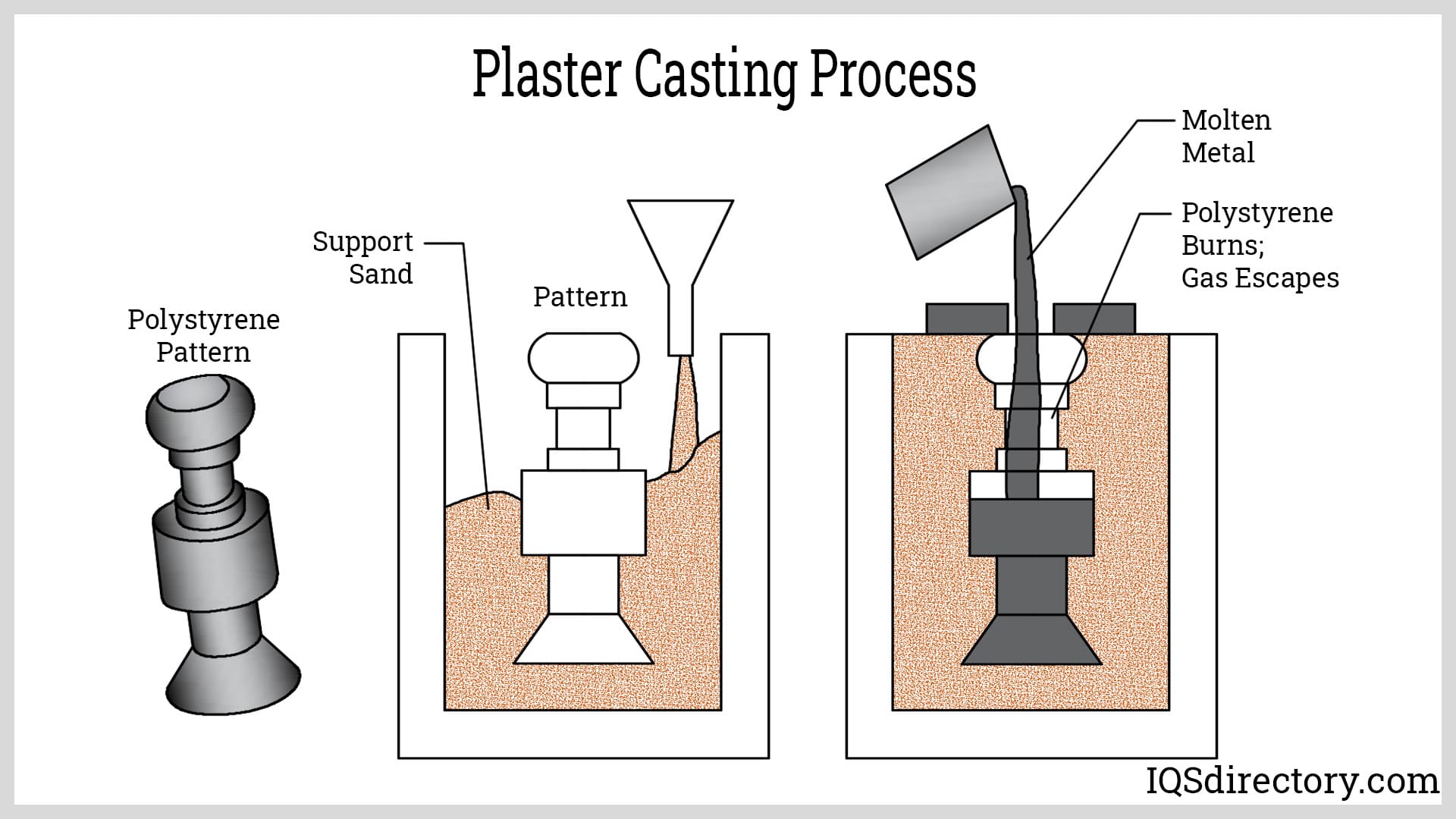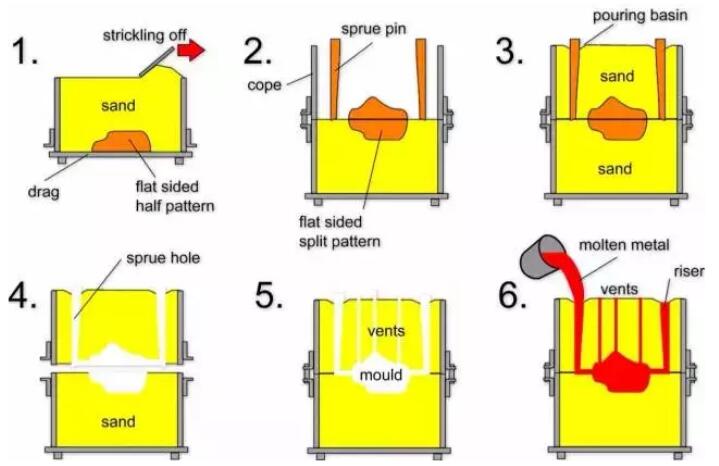How Aluminum Castings support construction applications with strength and quality
Wiki Article
Comprehending the Steel Castings Refine: A Comprehensive Guide for Beginners
The Metal Casting procedure is a fundamental technique in producing that changes molten metal into solid forms. Novices need to comprehend the numerous methods entailed, such as sand spreading and die casting. Understanding the materials, layout principles, and security steps is equally important. Each aspect plays an essential role in achieving successful end results. As one navigates these intricacies, the inquiry of how to maximize each action for enhanced results becomes increasingly pertinent.The Fundamentals of Metal Casting
Metal Casting has progressed over centuries, its essential principles remain consistent and integral to the production procedure. At its core, Metal Casting includes the change of liquified metal right into solid things with numerous methods. The process starts with the creation of a mold and mildew, which defines the shape of the final item. Once the mold and mildew is prepared, steel is heated to its melting factor and poured into the dental caries. After cooling, the metal strengthens, taking the form of the mold.There are numerous casting methods, consisting of sand casting, financial investment casting, and die spreading, each with special benefits and applications. The option of method relies on aspects such as production volume, product type, and wanted precision. As soon as cast, the end product might go through added procedures like machining or surface area therapy to accomplish the needed coating and specs. Comprehending these fundamentals is important for anybody interested in the field of Metal Casting.

Comprehending Materials Used in Metal Casting
Materials play a crucial function in the Metal Casting procedure, affecting the last product's residential or commercial properties and efficiency. Numerous metals are utilized, including light weight aluminum, iron, bronze, and steel, each offering distinctive attributes suited for details applications. Light weight aluminum is corrosion-resistant and lightweight, making it suitable for vehicle components. Iron, especially cast iron, is preferred for its outstanding wear resistance and toughness. Steel provides high strength and convenience, frequently utilized in hefty equipment components. Bronze, known for its deterioration resistance and machinability, is typically utilized in aquatic applications.Along with the metals, numerous casting products, such as sand, plaster, and ceramic, are utilized to produce molds. Sand casting, one of the most prevalent approach, makes use of silica sand because of its thermal security and ability to develop complex shapes. Plaster and ceramic mold and mildews offer finer details but might require even more complicated procedures. The option of products directly affects the performance, cost, and quality of the spreading operation.
The Style Refine: From Idea to Blueprint
The layout process in Metal Casting begins with the initial concept growth, where concepts are created and assessed. This is followed by the application of CAD modeling techniques, allowing for specific visualizations of the style. The blueprint completion actions ensure that all specs are precisely recorded for production.Initial Idea Development
First concept advancement marks a crucial phase in the Metal Casting procedure, where ideas transform right into substantial styles. Throughout this phase, developers team up with engineers and stakeholders to brainstorm and fine-tune first ideas. They think about variables such as functionality, visual appeals, and manufacturability, making certain that the design satisfies the needed specs and efficiency standards. Sketches and rough drafts are developed to imagine the concepts, allowing for initial assessments of usefulness and cost-effectiveness. This phase additionally entails identifying materials and possible spreading methods that straighten with the design goals. Eventually, preliminary concept advancement prepares for a comprehensive blueprint, leading the subsequent phases of the spreading process and guaranteeing a successful shift from principle to fact.CAD Modeling Techniques
Transforming ideas right into precise layouts, CAD modeling techniques play a pivotal duty in the Metal Casting procedure. These strategies make use of innovative software program to produce thorough three-dimensional designs that precisely show the desired item. By using tools such as parametric modeling, solid modeling, and surface area modeling, developers can adjust measurements and shapes effortlessly. CAD systems additionally help with simulation and evaluation, permitting for the recognition of possible defects before manufacturing starts. This proactive method lowers product waste and optimizes the layout for manufacturability. Additionally, CAD models can be quickly changed, enabling fast versions based on feedback. Basically, CAD modeling acts as the backbone of the design procedure, connecting the space in between preliminary principles and the ultimate production-ready layouts.Blueprint Finalization Steps
Adhering to the creation of thorough CAD versions, the following phase involves plan completion, which is crucial in translating electronic designs into actionable prepare for manufacturing. This procedure begins with examining the CAD versions for precision and conformity with specifications. When confirmed, the dimensions, resistances, and material requirements are meticulously described to assure clarity. Including comments and notes aids interact important information pertaining to spreading processes, surface finishes, and setting up demands. The wrapped up plan undertakes a strenuous authorization process, usually including partnership with engineers and manufacturing teams to resolve any type of possible problems. Alterations are made and authorizations acquired, the blueprint is officially released, offering as the foundational file for the subsequent stages of Metal Casting, consisting of pattern making and mold design.The Steel Casting Strategies Clarified

Metal Casting techniques encompass a selection of methods made use of to shape liquified steel into preferred forms. These strategies vary according to the sort of material, complexity of the style, and production volume. Sand casting is among the most common methods, involving the production of a mold and mildew from sand to hold the liquified steel. Financial investment spreading, or lost-wax casting, permits detailed designs by utilizing a wax pattern that is thawed away. Die casting employs high-pressure injection of molten steel into a mold and mildew, appropriate for automation. Other approaches include long-term mold spreading, which makes use of recyclable molds, and centrifugal spreading, where rotational pressures assist in loading the mold. Each strategy has its applications and advantages, making it essential for suppliers to select the suitable approach based on their particular demands and demands. Comprehending these techniques is crucial for anybody associated with the Metal Casting process.
Completing Processes: Enhancing Your Casted Item

Completing processes play an essential role in improving the quality and appearance of casted products. Numerous surface treatment strategies, such as polishing and covering, are utilized to boost durability and appearances. In addition, top quality assessment methods assure that the end product satisfies specified requirements and efficiency demands.
Surface Area Therapy Techniques
A selection of surface area treatment strategies play a necessary function in enhancing the high quality and longevity of casted products. These strategies consist of methods such as shot blasting, polishing, and finishing. Shot blasting efficiently removes surface flaws, boosting the visual and useful characteristics of the casting. Sprucing up provides a smooth finish, which is particularly important for attractive applications and elements calling for minimal friction. Covering techniques, such as electroplating or powder finish, deal additional security against deterioration and wear, ensuring resilience. Furthermore, surface area treatments can improve attachment for succeeding Aluminum Foundry processes, such as paint or bonding. By utilizing these methods, producers can attain remarkable surface area quality, which is vital for the efficiency and life expectancy of Metal Casting in numerous applications.Quality Assessment Approaches
Reliable quality examination approaches are important for ensuring the stability and efficiency of casted items after the finishing processes. Numerous methods are employed to evaluate the high quality of Metal Casting, consisting of aesthetic assessment, dimensional checks, and non-destructive screening (NDT) Aesthetic examination enables the identification of surface area issues, while dimensional checks assure that products satisfy specified tolerances. NDT methods, such as ultrasonic testing and radiographic assessment, give much deeper insights right into internal honesty without damaging the castings. In addition, mechanical testing, such as tensile and firmness tests, assesses product buildings - Aluminum Foundry. By employing a mix of these approaches, suppliers can enhance product high quality and reliability, inevitably causing better client satisfaction and lowered production pricesSafety And Security Considerations in Metal Casting
While the Metal Casting procedure offers countless benefits, it likewise presents an array of safety and security threats that must be meticulously taken care of. Workers in casting facilities are revealed to heats, liquified steels, and hazardous materials, which can lead to severe injuries if proper preventative measures are not taken. Personal protective equipment (PPE) such as heat-resistant handwear covers, deal with shields, and protective garments is vital to reduce threats.In addition, the visibility of fumes and dust demands correct air flow systems to assure air top quality - Aluminum Foundry. Routine training on safety and security procedures is essential for all workers to recognize prospective risks and respond properly. Emergency situation treatments ought to be established, including fire security actions and emergency treatment schedule. Maintenance of tools and proper handling of products better add to a safer working environment. By focusing on these safety and security considerations, Metal Casting operations can shield their workforce and preserve efficient manufacturing processes
Frequently Asked Questions
What Are the Ecological Impacts of Metal Casting?
Metal Casting can lead to ecological impacts such as air and water contamination, source exhaustion, and power usage. In addition, improper waste administration and discharges from foundries add to ecological disturbances and health and wellness risks for close-by areas.Exactly how Do I Pick the Right Steel for Casting?
To pick the best metal for casting, one must take into consideration factors such as mechanical residential or commercial properties, rust resistance, thermal conductivity, and expense. Examining the desired application and ecological problems is important for suitable option.What Are the Common Problems in Metal Casting?
Usual problems in Metal Casting include porosity, contraction, sand incorporation, and misruns. These concerns frequently develop from incorrect product selection, poor design, or problems in the spreading process, influencing the end product's top quality and efficiency.
Just How Can I Improve My Metal Casting Skills?
To improve Metal Casting abilities, one must practice continually, study casting strategies, evaluate previous tasks for defects, look for responses from seasoned wheels, and continually trying out different materials and approaches to enhance efficiency and understanding.What Is the Expense of Beginning a Steel Casting Organization?
Starting a metal spreading service normally calls for an initial investment of $5,000 to $50,000, depending on equipment, products, and center costs. Factors like area and scale can considerably affect general start-up costs.The Metal Casting procedure is an essential method in making that changes molten metal into strong types. Beginners must realize the various methods included, such as sand spreading and pass away spreading. There are numerous casting methods, including sand spreading, investment casting, and die casting, each with distinct advantages and applications. Investment spreading, or lost-wax spreading, permits for elaborate layouts by making use of a wax pattern that is melted away. Other approaches consist of long-term mold and mildew spreading, which utilizes multiple-use mold and mildews, and centrifugal spreading, where rotational pressures help in filling the mold.
Report this wiki page